The stages of play development
When do children learn to play with others? Why is ‘play’ so important? What can I do to play with my child at home?
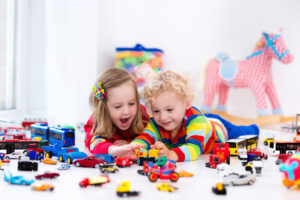 These are all questions Brisbane north parents ask when beginning to understand what play is. So let’s start with learning more about what play is.
These are all questions Brisbane north parents ask when beginning to understand what play is. So let’s start with learning more about what play is.
Play to a child and play to an adult can be viewed so differently. There is no one way to play. Play is extremely versatile and can be different things to different people.
Play is one of the most important occupations in a child’s life and incredibly crucial for their social, emotional and physical development.
Play gives your child many opportunities to observe, explore, experiment and learn to problem solve.
Play can come in many forms, including:
- structured play,
- exploratory play,
- social play,
- active play and
- pretend play… just to name a few.
Often, children’s first experience in play is sensory-motor play, where they learn to make sense of their body and their world. This is also known as ‘pre-imaginative play’ and is essential that these skills are present for engagement in pretend play development later on.
Development of pretend play skills begin right from birth with significant development occurring between 12 months to 5 years of age. It is important to note though that each and every child goes through development at their own pace and in their own time.
Below is a list of some of the skills that emerge in neurotypical play development, alongside approximate age ranges. At Cooee we want to emphasise that individual are unique, and development will look different for different children and this should be embraced.
Use the list below more like a series of steps, or stages of growth that children may go through, depending on their developmental profile. Based on the play that your child does do – you can practice stretching, expanding, or suggesting new types of play that are a stage above their current skills, to shape their play development.
0-6 months:

At this age, babies learn best when they are actively involved and having fun with you during everyday activities. They learn through exploring their environment- listening, looking, sucking, touching, smelling, dropping and shaking. In the first month or two of life, newborns depend on others to lead the interaction, but by the end of the third month, your baby will engage you with vocalizations and changes in facial expressions.
- Manipulates a rattle
- Laughs in response to play
- Establishes eye contact for a few seconds
- Responds with a smile
- Manipulates and explores objects
6-12 months (Pre-pretend play):
- Child manipulates and explores objects
- Child uses repetitive actions to show interest eg putting objects in and out of a container
- Child watches and imitates people making familiar gestures
- Child plays peek-a-boo
- Child extends toys to others
- Child manipulates a teddy or doll
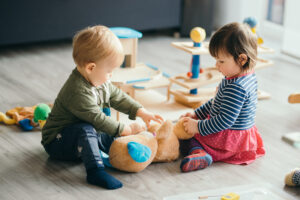
12-19 months (Pretend play emerges):
Pretend play is the highest level of play ability and provides opportunities for children to build their imagination, creativity and support both their social and emotional development.
Through pretend play, children also build their language and communication, as well develop their problem solving skills.
Pretend play begins to emerge by the time a child is one and a half to two years old.
This is where you may see your child using a block as a phone or placing a cup to a doll’s mouth. Through pretend play children will often initiate through their play things they have seen or heard in their day to day lives.
- Child performs one action with a doll or teddy eg hugging
- Child orients doll to the correct position (the doll is not upside down)
- Child copies an action that they have previously seen eg drinking or eating
- Child continued to explore and manipulate objects, further understanding the functional use of them
- Play scripts are body based eg pretending to drink from a cup, sleeping
- One simple play action is repeated eg talking on pretend phone, pushing a toy car
- May observe other children playing around them but will not play with them
- Difficulty sharing their toys with other children
- Children want to play by themselves and do not show interest in what others are doing
19-23 months
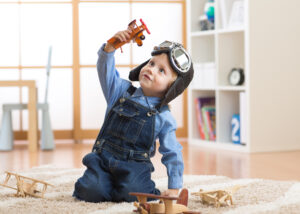 Begin to observe other children’s play without joining in
Begin to observe other children’s play without joining in- Play scripts reflect day to day activities in the home eg washing dishes, vacuuming
- Child carries out simple actions they have previously seen
- Uses similar looking objects in place of ‘real’ objects eg block is a phone, paper is a blanket, box is a bed. This is known as object substitution
- Child uses 2-3 similar actions that are illogical and repeated through their play
- Child can imitate an adult using object substitution
- Child can sit doll in a bed or on a chair and may relate actions to the doll (eg baby drinking, baby sleeping) but each action is single separate actions
- Child may request or search for play materials
24-29 months
- Child can asks adults for toys needed in play and can search for materials themselves
- Play scripts reflect activities inside and outside the home, as well as body scripts. These scripts reflect the child’s own life experiences eg going to the shops, restaurants
- Child can complete 2-3 simple play actions that are logical and intentional eg pour tea, stir tea, drink tea OR truck drives, truck picks up blocks,
- Child can use the same object for two different purposes eg a box can be used as a car and a bed
- Child sees doll/teddy as being ‘alive’ and it can do things by itself
- Child can imitate another person and their characteristics
30-35 months- 2 ½ years 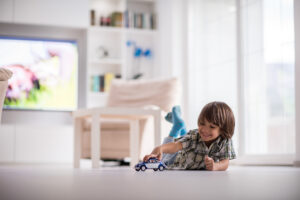
- Child will play alongside or near another child, however, won’t play with them (Associative play stage)
- Play scripts reflect less frequently experienced events eg going to the doctor, zoo, on a plane
- Play actions are more detailed and logical. They include longer sequences of 6-7 actions
- Child can use the same object for multiple different functions eg a box is a table, bed, oven etc. The child is also able to impose an absent object eg imaginary cake on plate
- Child can use more abstract objects as a doll e.g. use a peg as a person. The doll can also interact with imaginary characters.
- Child starts to imitate someone else and can indicate they are someone else for short periods of time (sometimes less than one minute) eg doctor or a mother
36-41 months- 3 years (Fantasy play emerges)
- Play scripts expand beyond personal experiences and start to include ideas from TV shows, books and movies. Here they may mix in their own original idea with what they have previously seen from media
- Child uses multiple logical play actions. This can last up to 15 minutes
- Child uses many different objects to create a new play item eg using blocks to build a wall or make a car
- Child indicates they are taking on a role and can play lots of different people in a short amount of time
- The doll or teddy is more active and has its own emotions. A child can also use multiple rooms of a doll’s house
- Children will play beside one another playing the same activity. For example, playing with building blocks but everyone is making their own tower. There is not a lot of interaction at this stage, however, the child begins to show interests in others.
41-47 months- 3 ½ years
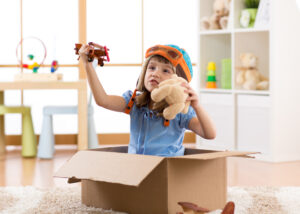 Play scripts continue to have fantasy elements, but now your child may include problems in the play eg sick doll, car broken down
Play scripts continue to have fantasy elements, but now your child may include problems in the play eg sick doll, car broken down - Doll and teddy play continues to extend with the toy now displaying multiple emotions and being given personality characteristics eg good, silly, naughty. A child can also use multiple rooms of a doll’s house and sort furniture
- Child will start thinking about what they want to play and finding the materials needed prior to commencing play
- Child will uses their body (eg leg is a fence) and refers to imaginary objects as part of the play
- Child can sustain their own play for up to one hour throughout the course of the day using multiple roles eg shopkeeper, pirate, fairy, doctor
- Child will play alongside or near another child engaging in the same activity. Here you may hear lots of talking between one another.
48-59 months- 4 years
- Play scripts can be carried over multiple days (2-3 days) and now include bigger problems to solve.
- Child continues to invent more complex problems in the play and put together more complex sequences eg child makes dinner and while it is cooking, baby gets sick, calls the doctor and gives food to the toy dog
- Child can use objects with no physical similarity to its intended object eg shoe can be a phone
- The doll/teddy has its own life and its own thoughts and feelings
- Children can take on several roles in a play scene e.g. may be a chef, then the customer. The child can take on multiple roles when playing with peers.
- Child can now co-operate and negotiate their play with other children where a clear story is evident
5 years 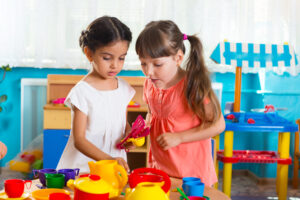
- Play is more complex and organised, and may last over 2-3 weeks. Play stories can reflect anything the child can think of including, fantasy characters or events, real life events, or events the child has never seen or experienced
- Usually prefers to play with other children than playing by themselves
- Enjoys playing games with simple rules
- Child can use any object and make up a use for it. They use language to describe an object and its function
- The doll/teddy has its own life and its own thoughts and feelings
- Child can maintain a role for an entire play scene
- Children can co-operate and negotiate their play, playing for a whole day with friends
Play is complex, dynamic and exciting! Playing supports children to learn, develop their ideas, and understand themselves and the world around them. Embracing play, joining your child/ren in their play and having fun are SO important, and we encourage parents and carers to let go of being an ‘adult’ for a while – and enjoy playing!
Sometimes it might not be clear whether your child needs support to develop their play skills. If you have any concerns about your child’s engagement or development in play or if you would like more information about play, please feel free to contact us to chat with our Occupational Therapists.

Written by Helena Manicaros, Occupational Therapist
References:
